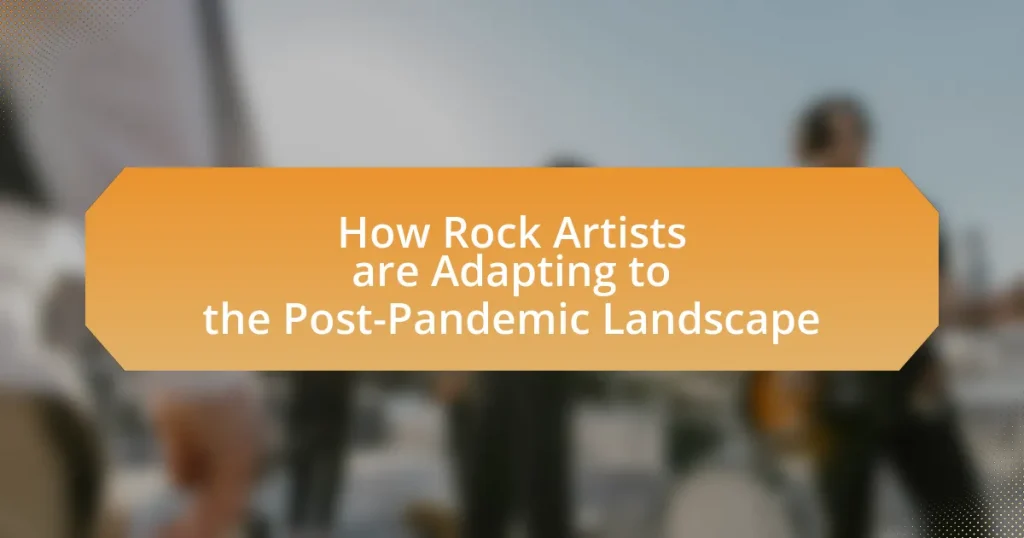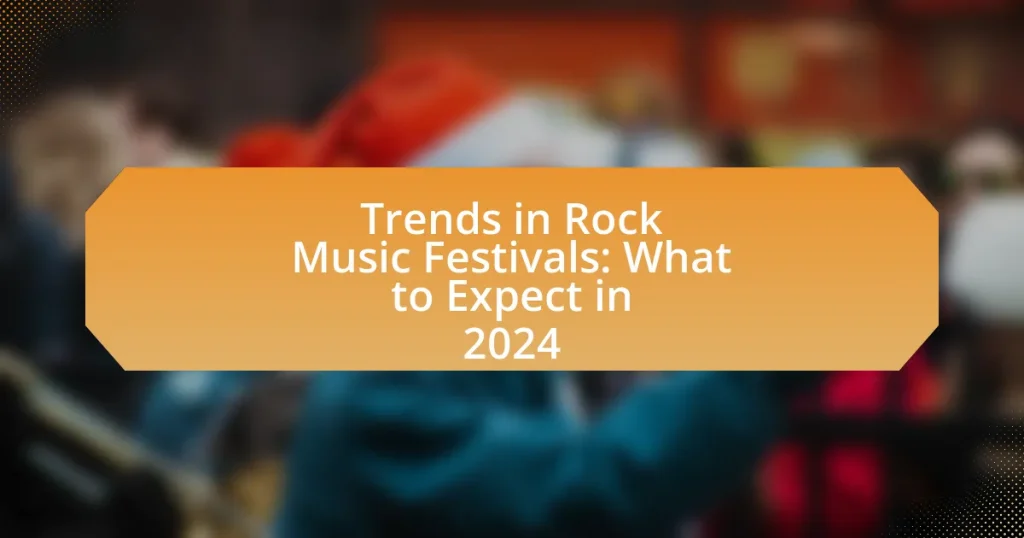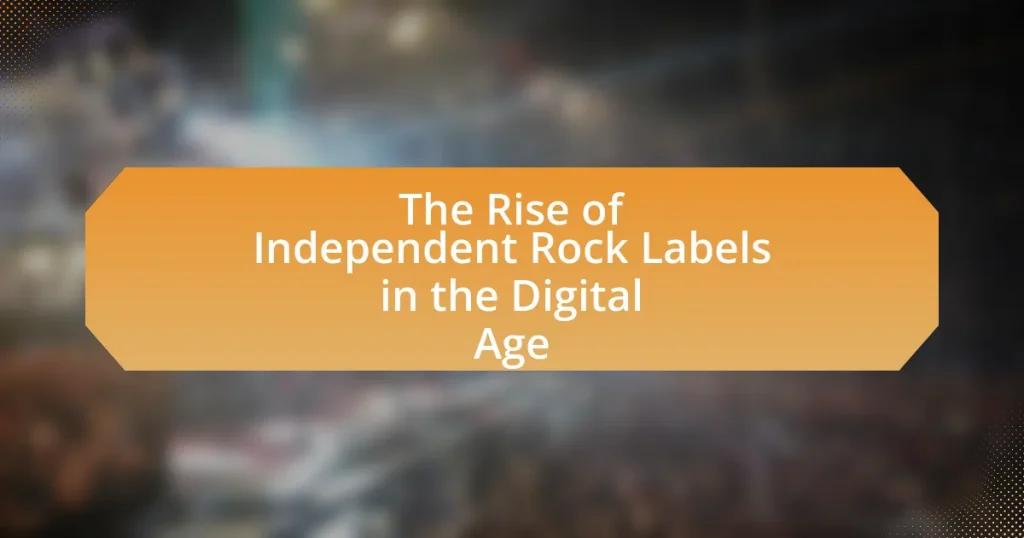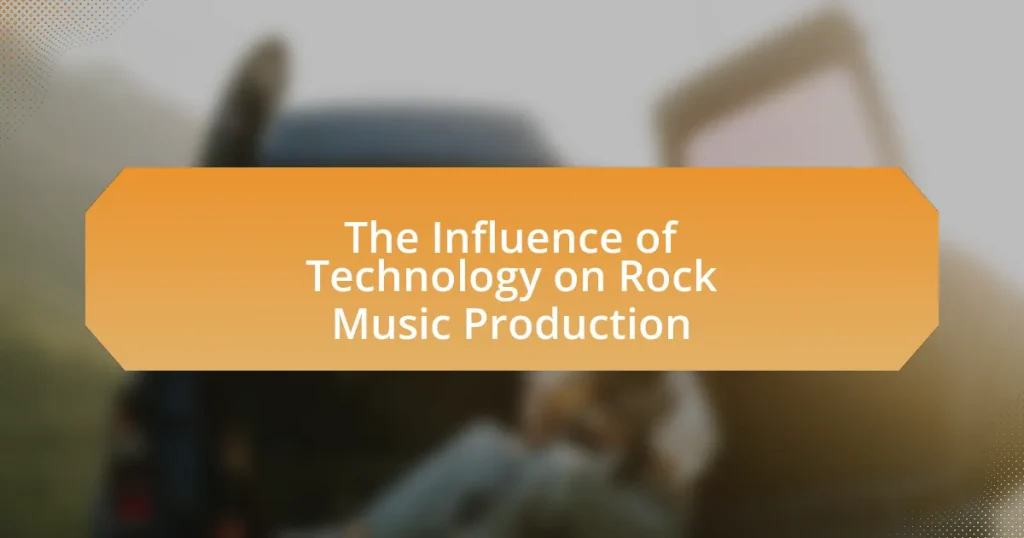The article examines how rock artists are adapting to the post-pandemic landscape, focusing on their responses to changes in the music industry. It highlights the shift towards digital platforms for live performances, increased engagement through social media, and the rise of direct-to-fan sales. The challenges faced by artists, including reduced live performance opportunities and financial impacts, are discussed alongside their innovative strategies for audience engagement and collaboration. Additionally, the article explores the evolving creative processes, marketing strategies, and safety measures being implemented as artists prepare for a return to live performances.

How are Rock Artists Responding to the Changes in the Music Industry Post-Pandemic?
Rock artists are responding to changes in the music industry post-pandemic by embracing digital platforms for live performances and engaging with fans through social media. Many artists have shifted to virtual concerts and livestream events, which became essential during lockdowns, allowing them to maintain visibility and connect with audiences. For instance, bands like Foo Fighters and Pearl Jam have utilized platforms like YouTube and Twitch to reach fans directly, demonstrating adaptability in their promotional strategies. Additionally, artists are increasingly focusing on direct-to-fan sales through platforms like Bandcamp, which saw a significant increase in usage during the pandemic, allowing musicians to retain a larger share of revenue. This shift reflects a broader trend in the industry towards independent distribution and a more personal connection with fans.
What challenges are Rock Artists facing in the post-pandemic landscape?
Rock artists are facing significant challenges in the post-pandemic landscape, primarily due to reduced live performance opportunities and shifting audience engagement. The pandemic led to widespread cancellations of tours and festivals, which are crucial revenue sources for rock musicians. According to a 2021 report by the International Federation of the Phonographic Industry, global recorded music revenues increased, but live music revenues plummeted by 75%, highlighting the financial strain on artists reliant on performances. Additionally, the transition to digital platforms for engagement has created a need for artists to adapt their marketing strategies and connect with fans in new ways, often requiring skills in social media and online content creation that many traditional rock artists may not possess.
How has the pandemic affected live performances for Rock Artists?
The pandemic significantly disrupted live performances for rock artists by leading to widespread concert cancellations and venue closures. In 2020, the live music industry faced a loss of approximately $30 billion in revenue due to restrictions on gatherings and social distancing measures. Many rock artists were forced to pivot to virtual performances, utilizing platforms like YouTube and Instagram Live to reach their audiences. This shift not only altered the traditional concert experience but also prompted artists to explore new revenue streams, such as merchandise sales and exclusive online content. As a result, the pandemic has fundamentally changed how rock artists engage with fans and structure their performances.
What financial impacts have Rock Artists experienced due to the pandemic?
Rock artists have experienced significant financial impacts due to the pandemic, primarily through the cancellation of live performances and tours, which are crucial revenue sources. According to a report by the National Independent Venue Association, 90% of independent venues faced closure, leading to a loss of income for artists who rely on live shows for up to 75% of their earnings. Additionally, merchandise sales declined as physical events were restricted, further straining artists’ finances. The overall music industry revenue dropped by 25% in 2020, highlighting the severe economic challenges faced by rock artists during this period.
How are Rock Artists adapting their creative processes in response to the pandemic?
Rock artists are adapting their creative processes in response to the pandemic by increasingly utilizing digital platforms for collaboration and performance. Many artists have shifted to virtual songwriting sessions, leveraging tools like Zoom and online DAWs (Digital Audio Workstations) to create music remotely. This adaptation has been essential as traditional in-person interactions were restricted, allowing artists to maintain productivity and connect with collaborators worldwide. Additionally, live-streaming concerts have become a primary means of reaching audiences, with platforms like Twitch and YouTube facilitating performances that were previously held in physical venues. This shift not only helps artists sustain their careers during lockdowns but also expands their reach to global audiences, as evidenced by the significant increase in online viewership for live-streamed events during the pandemic.
What new trends in songwriting and production have emerged?
New trends in songwriting and production include the increased use of virtual collaboration tools and a focus on genre-blending. Rock artists are now leveraging platforms like Splice and Soundtrap to collaborate remotely, which became essential during the pandemic. Additionally, there is a noticeable shift towards incorporating elements from various genres, such as electronic and hip-hop, into rock music, reflecting a broader trend of musical fusion. This evolution is supported by data showing that genre-blending tracks have gained significant streaming traction, indicating a shift in listener preferences.
How are collaborations changing among Rock Artists in this new environment?
Collaborations among rock artists are increasingly becoming more diverse and digital in this new environment. The rise of online platforms has enabled artists to connect across geographical boundaries, leading to more cross-genre collaborations and innovative projects. For instance, the pandemic accelerated the use of virtual recording sessions, allowing artists to collaborate remotely, which was exemplified by the release of “Lockdown Sessions” by various rock bands. This shift not only broadens the creative possibilities but also reflects a growing trend of inclusivity and experimentation within the rock genre.

What strategies are Rock Artists employing to engage with their audiences?
Rock artists are employing a variety of strategies to engage with their audiences, including leveraging social media platforms, hosting virtual concerts, and creating interactive content. Social media allows artists to connect directly with fans, share behind-the-scenes content, and promote new music, which has become increasingly important in a digital-first environment. Virtual concerts have gained popularity, with artists like Travis Scott and Billie Eilish successfully using platforms like Fortnite and YouTube to reach millions of viewers, demonstrating the effectiveness of this approach. Additionally, interactive content such as live Q&A sessions and fan polls fosters a sense of community and involvement, enhancing audience engagement. These strategies reflect a shift in how rock artists are adapting to the post-pandemic landscape, focusing on digital interaction to maintain and grow their fan base.
How are Rock Artists utilizing digital platforms to connect with fans?
Rock artists are utilizing digital platforms to connect with fans by engaging in live streaming concerts, sharing exclusive content, and fostering community interaction through social media. For instance, platforms like Instagram and Facebook allow artists to host virtual performances, which gained popularity during the pandemic, with a reported increase in viewership by over 50% for many artists. Additionally, services like Patreon enable musicians to offer fans exclusive behind-the-scenes content and personalized experiences, enhancing fan loyalty and interaction. This strategic use of digital tools not only maintains fan engagement but also expands their reach to global audiences, as evidenced by the rise in online ticket sales and merchandise purchases during virtual events.
What role do social media and streaming services play in this engagement?
Social media and streaming services are crucial in engaging rock artists with their audiences in the post-pandemic landscape. These platforms enable artists to share music, connect with fans, and promote events directly, fostering a sense of community and interaction. For instance, a study by the International Federation of the Phonographic Industry (IFPI) in 2021 highlighted that 50% of music listeners discovered new artists through social media, demonstrating its effectiveness in audience engagement. Additionally, streaming services like Spotify and Apple Music provide artists with data analytics, allowing them to tailor their marketing strategies based on listener preferences and behaviors, further enhancing engagement.
How are virtual concerts reshaping the live music experience for Rock Artists?
Virtual concerts are reshaping the live music experience for rock artists by expanding their audience reach and providing innovative engagement opportunities. These online performances allow artists to connect with fans globally, breaking geographical barriers that traditional concerts impose. For instance, a study by the International Music Summit in 2021 indicated that virtual concerts increased audience numbers by up to 300% compared to in-person events, demonstrating a significant shift in how rock artists can engage with their fan base. Additionally, virtual platforms enable artists to experiment with multimedia elements, enhancing the overall concert experience through interactive features and unique visual presentations. This evolution not only diversifies revenue streams but also fosters a more inclusive environment for fans who may not have access to live shows.
What innovative marketing strategies are Rock Artists adopting?
Rock artists are adopting innovative marketing strategies such as leveraging social media platforms for direct fan engagement and utilizing virtual reality experiences to enhance live performances. These strategies allow artists to create immersive content that resonates with audiences, fostering a deeper connection. For instance, many rock artists have successfully hosted live-streamed concerts on platforms like Instagram and YouTube, which saw significant viewer engagement during the pandemic, with some events attracting millions of viewers globally. Additionally, collaborations with brands for exclusive merchandise and limited-edition releases have become common, providing fans with unique offerings that enhance their loyalty and support.
How are Rock Artists leveraging merchandise and exclusive content to boost revenue?
Rock artists are leveraging merchandise and exclusive content to boost revenue by creating unique products and experiences that resonate with their fan base. For instance, many artists have launched limited-edition merchandise, such as vinyl records, apparel, and collectibles, which not only enhance fan engagement but also drive sales. According to a report by the Music Industry Association, merchandise sales can account for up to 30% of an artist’s total income, especially during tours. Additionally, artists are offering exclusive content through platforms like Patreon or Bandcamp, where fans can access behind-the-scenes footage, early releases, and personalized experiences. This strategy not only generates direct revenue but also fosters a deeper connection with fans, leading to increased loyalty and long-term financial support.
What impact does fan interaction have on marketing efforts for Rock Artists?
Fan interaction significantly enhances marketing efforts for rock artists by fostering deeper connections and increasing audience engagement. When rock artists actively engage with their fans through social media, live streams, and interactive content, they create a sense of community that encourages loyalty and word-of-mouth promotion. For instance, a study by the International Journal of Music Business Research found that artists who interact with fans on platforms like Instagram and Twitter see a 30% increase in concert attendance and merchandise sales. This direct engagement not only amplifies their reach but also allows artists to gather valuable feedback, tailor their marketing strategies, and ultimately drive revenue in a competitive landscape.
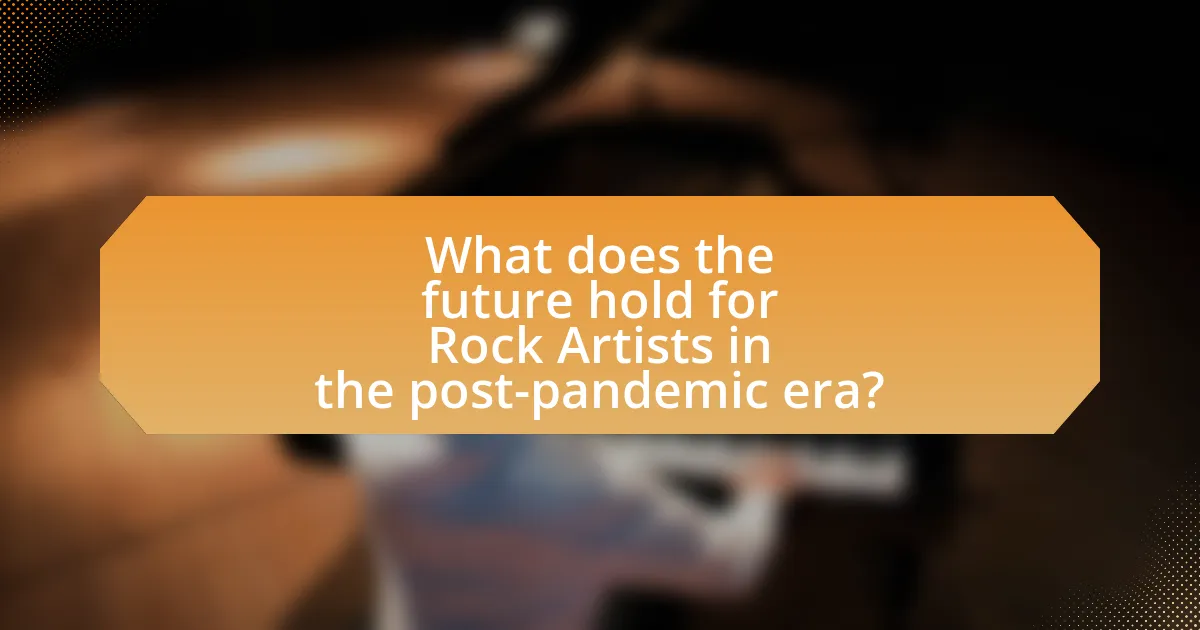
What does the future hold for Rock Artists in the post-pandemic era?
The future for rock artists in the post-pandemic era is characterized by increased digital engagement and innovative live performance strategies. Rock artists are adapting by leveraging streaming platforms and social media to reach wider audiences, as evidenced by a 2021 report from the International Federation of the Phonographic Industry, which noted a 20% increase in music streaming during the pandemic. Additionally, many artists are exploring hybrid concert formats that combine in-person and virtual experiences, allowing them to connect with fans globally while adhering to health guidelines. This shift not only enhances accessibility but also opens new revenue streams, indicating a resilient evolution in the rock music landscape.
How are Rock Artists planning for a return to live performances?
Rock artists are planning for a return to live performances by implementing enhanced safety protocols and exploring innovative concert formats. Many artists are collaborating with venues to ensure compliance with health guidelines, such as reduced capacity, social distancing, and mandatory vaccinations or negative COVID-19 tests for attendees. Additionally, some rock artists are incorporating virtual elements into their shows, allowing for hybrid performances that reach wider audiences while maintaining safety. For instance, the band Foo Fighters has announced plans for shows that include both in-person and live-streamed options, reflecting a trend towards flexibility in concert experiences. This approach not only addresses health concerns but also adapts to changing audience preferences in the post-pandemic landscape.
What safety measures are being implemented for concerts and festivals?
Safety measures being implemented for concerts and festivals include enhanced health screenings, mandatory mask-wearing, and social distancing protocols. These measures aim to minimize the risk of COVID-19 transmission among attendees. For instance, many events now require proof of vaccination or a negative test result prior to entry, ensuring that only individuals who are less likely to spread the virus can attend. Additionally, venues are often utilizing contactless ticketing and payment systems to reduce physical interactions. According to a survey by the National Independent Venue Association, 85% of venues have adopted these safety protocols to protect both staff and attendees, demonstrating a commitment to public health in the live music industry.
How are Rock Artists preparing for potential future disruptions?
Rock artists are preparing for potential future disruptions by diversifying their revenue streams and enhancing their digital presence. Many artists are investing in online platforms for live streaming concerts and engaging with fans through social media, which became crucial during the pandemic. For instance, a survey by the Music Industry Research Association found that 70% of artists increased their online engagement during the pandemic, indicating a shift towards digital strategies. Additionally, artists are exploring alternative income sources such as merchandise sales and crowdfunding, which provide financial stability in uncertain times. This proactive approach allows rock artists to remain resilient and adaptable in the face of future challenges.
What best practices can Rock Artists adopt to thrive in the new landscape?
Rock artists can thrive in the new landscape by embracing digital platforms for music distribution and fan engagement. Utilizing streaming services like Spotify and Apple Music allows artists to reach a global audience, as evidenced by the fact that over 60% of music consumption now occurs through streaming. Additionally, engaging with fans through social media platforms such as Instagram and TikTok fosters community and loyalty, which is crucial in a time when live performances are limited. Artists who adapt their marketing strategies to include virtual concerts and interactive online experiences can maintain visibility and revenue streams, as demonstrated by the success of virtual events during the pandemic, which attracted millions of viewers.
How can Rock Artists balance traditional and digital approaches effectively?
Rock artists can balance traditional and digital approaches effectively by integrating live performances with digital platforms for broader audience reach. For instance, artists can utilize social media and streaming services to promote their music while still engaging in live shows, which have historically been a cornerstone of rock culture. According to a 2021 report by the International Federation of the Phonographic Industry, 70% of music consumers engage with artists through digital channels, highlighting the importance of a dual approach. By combining the authenticity of live performances with the accessibility of digital media, rock artists can enhance their visibility and maintain fan engagement in a post-pandemic landscape.
What resources are available for Rock Artists to navigate this transition?
Rock artists can utilize various resources to navigate the transition in the post-pandemic landscape, including online platforms for virtual performances, social media for audience engagement, and digital distribution services for music release. These resources enable artists to reach wider audiences and maintain their presence despite physical venue limitations. For instance, platforms like Bandcamp and SoundCloud allow artists to distribute their music directly to fans, while social media channels like Instagram and TikTok facilitate real-time interaction and promotion. Additionally, organizations such as the American Federation of Musicians provide support and guidance on navigating industry changes, ensuring artists have access to essential information and networking opportunities.
